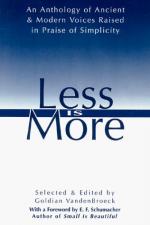
|
| Name: _________________________ | Period: ___________________ |
This test consists of 5 multiple choice questions, 5 short answer questions, and 10 short essay questions.
Multiple Choice Questions
1. ________ cautions against building one's house beyond reasonable expense and splendor, according to the book.
(a) Plutarch.
(b) Cicero.
(c) James.
(d) Whitman.
2. An _______ is a device that is used to purify things, according to the beginning of this section of the book.
(a) Alembic.
(b) Emberla.
(c) Atrophy.
(d) Enema.
3. Children should be taught that ________ is for warmth, for modesty, and for protection, according to the book.
(a) Money.
(b) Home.
(c) Wood.
(d) Clothing.
4. A person should not allow possessions to have any __________ in life, as this will cause the baggage to be a bother.
(a) Value.
(b) Significance.
(c) Weight.
(d) Truth.
5. Too often, the beauty and the size of one's _______ becomes more important than its cost.
(a) Car.
(b) Office.
(c) Home.
(d) Book study.
Short Answer Questions
1. Gandhi has experienced both ________ and poverty, but chooses poverty as this seems to help his work.
2. Mumford says that the _______ of the Affluent Economy would not be Karl Marx but Henry Thoreau.
3. Using _______, Marya Mannes writes a piece that addresses the avarice and the dysfunction of America in the book.
4. _______ proclaims that living the life of a philosopher is more than just loving wisdom and starting a school.
5. ________ does not limit how much is built on the lands or how many fish are taken from the waters, according to the book.
Short Essay Questions
1. What does Sir Francis Bacon have to say about the baggage that one carries in their life?
2. What does Gandhi discover as he has experienced both wealth and poverty?
3. What do artists and the creative community seem to understand that others do not?
4. What does Seneca point out that man does not limit when it comes to the use of nature?
5. What does Huxley have to say about the West and what it is doing to the world as it grows?
6. What does Russell say about the idea of saving for the future?
7. What does this section say that children are taught at a young age, which might explain modern society?
8. What does this section say is a part of human nature, and Gandhi says one must have faith in the future?
9. What should happen once wealth and possessions have been renounced, according to this section?
10. How do the bees build their own homes, which is clearly different from the way that humans build their homes?
|
This section contains 605 words (approx. 3 pages at 300 words per page) |

|




